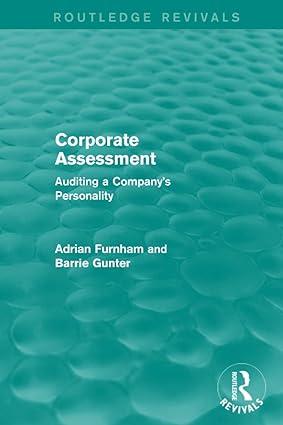Question
On January 1, 2019, Sharon Matthews established Tri-City Realty, which completed the following transactions during the month: Sharon Matthews transferred cash from a personal bank
On January 1, 2019, Sharon Matthews established Tri-City Realty, which completed the following transactions during the month:
- Sharon Matthews transferred cash from a personal bank account to an account to be used for the business, $21,000.
- Paid rent on office and equipment for the month, $3,880.
- Purchased supplies on account, $1,150.
- Paid creditor on account, $420.
- Earned fees, receiving cash, $17,640.
- Paid automobile expenses (including rental charge) for month, $1,080, and miscellaneous expenses, $720.
- Paid office salaries, $2,260.
- Determined that the cost of supplies used was $640.
- Withdrew cash for personal use, $1,040.
Required:
1. Journalize entries for transactions (a) through (i) (in chronological order), using the following account titles: Cash; Supplies; Accounts Payable; Sharon Matthews, Capital; Sharon Matthews, Drawing; Fees Earned; Rent Expense; Office Salaries Expense; Automobile Expense; Supplies Expense; Miscellaneous Expense. For a compound transaction, if an amount box does not require an entry, leave it blank.
| a. | |||
| b. | |||
| c. | |||
| d. | |||
| e. | |||
| f. | |||
| g. | |||
| h. | |||
| i. | |||
Feedback
1. Identify which accounts are affected in each transaction. Keep in mind that every transaction involves at least two accounts. Determine whether the account increases or decreases and record each increase or decrease following the rules of debit and credit. Remember total debits should equal total credits in your entries.
2. Prepare T accounts, using the account titles in (1). Post the journal entries to these T accounts, selecting the appropriate letter to the left of each amount to identify the transactions. Determine the account balances (when required), after all posting is complete, for all accounts having two or more debits or credits.
| Cash | |||
|---|---|---|---|
| Bal. | |||
| Supplies | |||
|---|---|---|---|
| Bal. | |||
| Accounts Payable | |||
|---|---|---|---|
| Bal. | |||
| Sharon Matthews, Capital | |||
|---|---|---|---|
| Sharon Matthews, Drawing | |||
|---|---|---|---|
| Fees Earned | |||
|---|---|---|---|
| Rent Expense | |||
|---|---|---|---|
| Office Salaries Expense | |||
|---|---|---|---|
| Automobile Expense | |||
|---|---|---|---|
| Supplies Expense | |||
|---|---|---|---|
| Miscellaneous Expense | |||
|---|---|---|---|
Feedback
2. Each increase or decrease recorded in the journal entries corresponds to a debit or credit in the T-accounts, following the rules of debit and credit. Net debits against credits to determine the balance in each T-account and double-check to see if it is a normal balance for that account classification.
3. Prepare an unadjusted trial balance as of January 31, 2019. For those boxes in which no entry is required, leave the box blank.
| Tri-City Realty | ||
| Unadjusted Trial Balance | ||
| January 31, 2019 | ||
| Debit Balances | Credit Balances | |
Feedback
3. Prepare the trial balance using the ending balances of the T-accounts. Again, double-check to see if each account has a normal balance for that account classification placed in the proper Debit or Credit column. The trial balance column totals should be equal.
4. As a result of the January transactions (a-i), determine the following:
a. Amount of total revenue recorded in the ledger. $
b. Amount of total expenses recorded in the ledger. $
c. Amount of net income for January. $
5. Determine the total increase or decrease in owner's equity for January. $
Step by Step Solution
There are 3 Steps involved in it
Step: 1

Get Instant Access to Expert-Tailored Solutions
See step-by-step solutions with expert insights and AI powered tools for academic success
Step: 2

Step: 3

Ace Your Homework with AI
Get the answers you need in no time with our AI-driven, step-by-step assistance
Get Started


